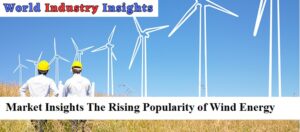Popularity of Wind Energy: In today’s rapidly evolving world, the global demand for renewable energy has been steadily increasing. As the detrimental effects of climate change become more apparent, countries, organizations, and individuals are actively seeking sustainable alternatives to traditional fossil fuels. Among the various renewable energy sources, wind energy has emerged as a leading contender, harnessing the power of nature to generate electricity efficiently and without harmful emissions.
Understanding Wind Energy
Wind energy refers to the conversion of wind power into usable electricity through the use of wind turbines. The concept of harnessing wind energy dates back centuries, with early civilizations using windmills for grinding grain and pumping water. However, technological advancements have significantly improved the efficiency and scale of modern wind turbines, making wind energy a viable and cost-effective solution for meeting the world’s growing energy needs.
Global Wind Energy Market Overview
The global wind energy market has experienced remarkable growth in recent years. With increasing investments and favorable government policies, the market size is projected to expand significantly in the coming years. Key players in the industry, such as Vestas, Siemens Gamesa, and GE Renewable Energy, are driving innovation and pushing the boundaries of wind turbine technology. The installation of wind farms is no longer limited to a few countries, as the geographic distribution of wind energy projects continues to expand across continents.
Environmental Benefits of Wind Energy
One of the most compelling reasons for the rising popularity of wind energy is its positive environmental impact. Unlike conventional power generation methods that rely on fossil fuels, wind energy is clean and renewable. By harnessing the power of the wind, wind turbines produce electricity without emitting greenhouse gases or other harmful pollutants. This reduction in carbon emissions helps combat climate change and promotes a healthier and more sustainable planet. Moreover, wind energy contributes to improved air and water quality, mitigating the negative effects of pollution on human health and ecosystems.
Technological Advancements in Wind Energy
The wind energy sector has witnessed remarkable technological advancements in recent years. Wind turbines have become larger, more efficient, and capable of generating higher outputs. The development of offshore wind farms has opened up vast untapped resources and overcome some of the limitations associated with land-based installations. Additionally, the integration of smart grid technology allows for better management and distribution of wind-generated electricity, making the overall power system more reliable and resilient.
Government Support and Policies
Governments worldwide are recognizing the importance of transitioning to clean energy sources and have implemented supportive policies and incentives to promote wind energy adoption. Many countries have set renewable energy targets and commitments to reduce reliance on fossil fuels. Government subsidies, tax incentives, and feed-in tariffs encourage private investments in wind energy projects. Moreover, regulatory frameworks and streamlined permitting processes facilitate the development and implementation of wind farms, reducing barriers to entry.
Investment and Financing Opportunities
The financial attractiveness of wind energy projects has made them an appealing option for investors. The consistent growth and profitability of the wind energy market, combined with long-term power purchase agreements, provide stable returns on investment. Public-private partnerships play a crucial role in financing wind energy projects, leveraging the expertise and resources of both sectors. Emerging trends in project financing, such as green bonds and renewable energy funds, offer additional avenues for investment and capital deployment.
Job Creation and Economic Impact
The widespread adoption of wind energy has significant socioeconomic benefits. The construction, operation, and maintenance of wind farms create employment opportunities in both rural and urban areas. Skilled jobs in manufacturing, installation, and maintenance contribute to local economies and foster regional development. Furthermore, wind energy projects stimulate ancillary industries, such as transportation and logistics, and attract investments in infrastructure, leading to a multiplier effect on the overall economy.
Challenges and Limitations
While wind energy holds immense potential, it is not without challenges. The intermittency of wind poses challenges for grid integration, as electricity generation depends on wind availability. Innovative solutions such as energy storage systems and improved grid management strategies are being developed to mitigate this issue. Environmental concerns, including the impact on wildlife and ecosystems, must also be addressed through careful planning and environmental impact assessments. Additionally, wind energy projects require substantial land and infrastructure, which can sometimes lead to conflicts over land use and visual impact.
Innovations and Future Prospects
The future of wind energy looks promising, with ongoing advancements and research in the field. Continued innovation in wind turbine technology, including larger and more efficient designs, will drive down costs and increase energy yields. Hybrid renewable energy systems, combining wind energy with other sources like solar or storage, offer potential solutions to address intermittency concerns. Market projections indicate substantial growth in the wind energy sector, as countries strive to achieve their renewable energy targets and the cost of wind energy continues to decline.
Case Studies: Successful Wind Energy Projects
Highlighting successful wind energy projects provides real-life examples of the benefits and outcomes. Notable installations, such as the Hornsea Offshore Wind Farm in the United Kingdom or the Alta Wind Energy Center in the United States, showcase the scale and impact of large-scale wind farms. Examining project implementation, technological innovations, and economic and environmental outcomes allows for a deeper understanding of the potential and success factors associated with wind energy projects.
Community Engagement and Public Perception
Public support and engagement play a crucial role in the successful deployment of wind energy projects. Educating communities about the benefits of wind energy, addressing concerns, and incorporating local stakeholders in the decision-making process are key to fostering acceptance and cooperation. Strategies such as open dialogue, transparency, and community benefits sharing can help build trust and ensure a smooth implementation process. Addressing misconceptions and providing accurate information about the impacts of wind energy also contribute to public perception and acceptance.
International Collaborations and Partnerships
International collaboration and knowledge-sharing are vital for accelerating the growth of wind energy on a global scale. Countries and organizations collaborate on research and development, sharing best practices and lessons learned. Collaborative projects and interconnectivity initiatives, such as the North Sea Wind Power Hub in Europe, showcase the potential for cross-border cooperation and the efficient utilization of wind resources. By pooling resources and expertise, countries can achieve their renewable energy goals more effectively.
Overcoming Barriers: Lessons from Different Regions
Different regions face unique challenges when it comes to wind energy adoption. Case studies from various countries, each with its own wind energy landscape, offer valuable insights into overcoming barriers. By analyzing successful strategies employed in diverse contexts, policymakers and stakeholders can learn from each other and adapt approaches that align with their specific circumstances. Whether addressing regulatory frameworks, community engagement, or technological advancements, sharing experiences fosters a collective learning environment.
Future Policy Recommendations
To accelerate the transition to a renewable energy future, certain policy recommendations can be considered. Strengthening renewable energy targets and commitments is essential to drive the adoption of wind energy and other clean sources. Enhancing regulatory frameworks and streamlining permitting processes can expedite project implementation while ensuring environmental and social considerations. Increased investment in research and development promotes further innovation and efficiency improvements in wind turbine technology and grid integration.
Conclusion of Popularity of Wind Energy
The rising popularity of wind energy stems from its immense potential to provide clean, renewable, and cost-effective electricity. The environmental benefits, technological advancements, government support, and investment opportunities make wind energy a compelling choice for a sustainable future. By addressing challenges, promoting public engagement, and fostering international collaborations, the wind energy sector can continue to thrive and contribute significantly to global efforts in combating climate change and securing a cleaner planet for future generations.
FAQs
Q1: How does wind energy help combat climate change?
Ans: Wind energy helps combat climate change by producing electricity without emitting greenhouse gases or other harmful pollutants. By replacing fossil fuel-based power generation with wind energy, we can reduce carbon emissions and mitigate the impacts of climate change.
Q2: Are wind turbines noisy and disruptive to local communities?
Ans: Modern wind turbines are designed to be quieter and less disruptive than earlier models. However, their placement and distance from residential areas are important considerations. Proper planning and community engagement can address concerns related to noise and visual impact, ensuring minimal disruption to local communities.
Q3: How do governments support the growth of wind energy?
Ans: Governments support the growth of wind energy through various policies and incentives. These may include renewable energy targets, subsidies, tax incentives, and streamlined permitting processes. By creating a favorable regulatory environment, governments encourage private investments in wind energy projects.
Q4: Can wind energy generate electricity consistently?
Ans: Wind energy generation is dependent on wind availability, which can vary. While intermittent, wind energy can be complemented by energy storage systems and smart grid technologies to ensure a more consistent and reliable electricity supply.
Q5: How can individuals contribute to the adoption of wind energy?
Ans: Individuals can contribute to the adoption of wind energy by supporting policies and initiatives that promote renewable energy, advocating for wind energy projects in their communities, and making conscious choices to use electricity from renewable sources. Small actions can collectively make a significant impact on the transition to a cleaner and more sustainable energy future.
Our Reader’s Queries
What is the current trend in wind energy?
The clean energy transition and the fight against climate change are being propelled forward by the latest wind power trends. The industry is being driven by technological advancements such as floating wind turbines, AI-powered predictive maintenance, modular wind systems, and offshore wind energy. These innovations are paving the way for a sustainable future and a cleaner planet.
When did wind energy become popular?
The surge in wind power’s popularity can be traced back to the 1970s when the world was hit by rising oil prices. This led to a growing interest in renewable sources of energy, and wind power emerged as a viable alternative. Since then, wind power has continued to gain momentum as a clean and sustainable energy source.
Why do people prefer wind energy?
Wind energy is a remarkable source of electricity that is both abundant and sustainable. Unlike traditional energy sources, it doesn’t require any fuel to generate power, which means it doesn’t pollute the air. This makes it an eco-friendly option that is perfect for those who want to reduce their carbon footprint. With its unique ability to harness the power of the wind, it’s no wonder that wind energy is becoming increasingly popular around the world.
Is the wind power industry growing?
The wind power market has been on the rise, with a current value of USD 99.28 billion in 2021. Experts predict that this market will continue to grow at a steady pace, with a compounded annual growth rate (CAGR) of 6.5% from 2022 to 2030. This is great news for the renewable energy industry and for those who are invested in it. As we move towards a more sustainable future, wind power is proving to be a reliable and efficient source of energy.



